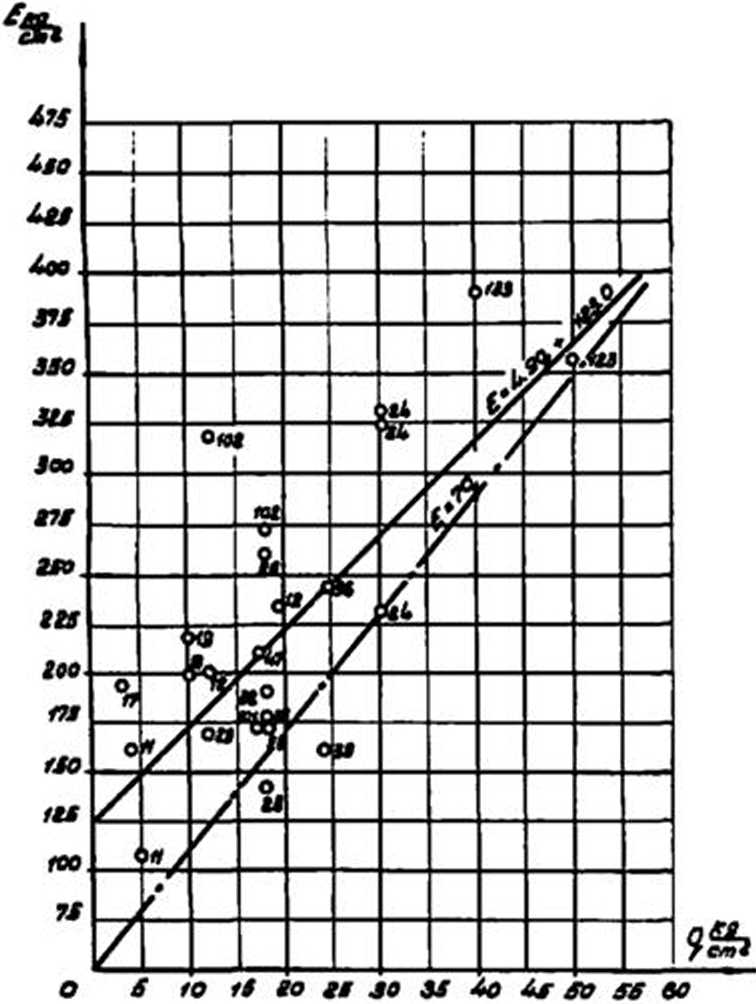6585844957
USSR 152
3. MODULUS OP DEFORMATION 4. allowable soil prbssurb
A lot of erperiments have reyealed that a rather reliable yalues of the mo-dulus of deformation may be determlned by the following fonaulae:
by the reeults of the statlc sounding:
B«7<ł (7)
by the results of the dynami o soundlngt Bc6pd (8)
The erperiment&l data on the relation-ahip between £ and q9 obtained by the results of 23 tests of the clay and sandy clay of stiff and very stiff oonais-tency are shown in Fig.6. The modulus of deformation yaried from 100 to 400 kg/cm2 and the point resistanoe - from
5 to 50 kg/cnr.

■pig.6 Relation between the modulus of deformation and the statlc point resistanoe in clay solls
The relationship between E and q may be ezpressed by the equation:
Ba 4,9a ♦ 123 (9)
The ooefficient of correlation is 0.® • The data mantioned aboye reyeal that formula (7) ensures reliable yalues of the modulus of defarmation* Howeyer, far smali yalues of q, the formula (7) un-derestimates the yalue of the modulus of deformation.
Por ordlnary buildings qq strip f oun-datioas of 0.6 to 1.5 m width and of the depth 1 to 2.5m it is allowed to de ter minę the pressure that can be app-11 ed on olays and sandy olays (qa) on the result of point reaistanoe fq) ac-cording to Tabla 4.
Table 4.
q kg/cm2 10 20 30 40 50 60
qakg/om2 1,2 2,2 3*1 4.0 4.9 5*8
B. DHEERMINATION OP THE BBARURr CAPACITT OP PILBS
The use of the statlc sounding for the determining of the bearing capacity of piles is one of the main ways of this method due to the direot analogy between penetrating a sounding tubę and driying a pile. The sounding tubę is taken as a model pile. Dynamio sounding for determining the bearing capacity of piles i s not used.
The ultimate resistanoe of a pile is determlned by the results of the sta-tic sounding as the sum of the point rasie tance and aide friction. It should be emphaslzed that in comparing the results of pile load tests and statlc sounding the conyentional ultimate pile load was taken at the settlement equal to 8 mm, i.e. 1/10 of the allowable settlement of a building (8 om) whloh is the usual praotice in the USSR when determining ultimate pile resistanoe by load tests. According to the Building Codę on the Design of Pile Poundations up to 1973 specific resistanoe of a pile point (R) was taken as one hall of the specific reaistance of a sounding point Ca) and specific friction on a pile (fp) as specific friction on a sounding tuce (f8). Por the determining of the bearing capacity of a pile (an allowable load) the ooefficient of reduction of 0.7 was introduoed, i.e. the ooefficient of safety of 1.4 was accepted to the aboyementioned conyentional ultimate load.
Thus, the bearing capacity of a pile (Pa) was determlned by the formula:
Pa=0,7(0,5qaip+ (10)
where Ap - area of a pile cross seotion Up - perima ter of a pile Ug - perimeter of a sounding tubę
Inyestigations of a pile driying showed that in the soil at a pile toe ahear and compression ocour, the grea-test compression stress be Ing approodma-tely 4 d below a pile point. Therefore, in determining the resistanoe of a pile. point, the mean cone reaL stance (qm) on the graph of sounding is taken on the length 4 d below and 1 d aboye a pile point (d - a pile side).
Wyszukiwarka
Podobne podstrony:
61 (152) 9<-et. op<a& /*« ^ j)SLyin<ji, *uiSe />&<-*
Rabeler, R.C., 1989. Soil Corrosion Evaluation of Screw Anchors. ASTMSTP 1013. pp. Radhakrishna, H.S
152 J. Ohnishi et al. Fig. 3. Cross-sectional view of a newly designed sex-tupole magnet. X(cm) Fig.
2C2 Arquivos de Zoologia cerithioideans except Modulus. The main character is the modification of sh
Fig.1 (above): an inveriing op amp . stage is the basis of the Circuit. Fig.2 (rtght): the addition
152 Marek Kwiatkowski, Izabella Grabowska-Lepczak, Monika Tryboń of the rescue forces as well as lac
USSR Eeonomic (Contd) USSR Econor>ic (Contd) Credit Relationshlps in the Period of the Building o
152 is recorded in Ewe as tu (]VIARET &NSUKA 1977:51) arguing that it is an ancient Niger-Congo
1. Błońska Ewa, Lasota Jarosław, Zwydak Maciej -Soil enzyme activity of diversifie
depression: the mcan yield was 7.1% of that in Slerilizccj soil. The yield of Lotus pedunculatus was
Slajd15 KESONY 5 finał sinking concrete pouring compact ed soil 1 first stage of constructłon Etapy
[80] Wierzcholski Krzysztof: Analytical designation of the thermal stress and deformation in the bou
[80] Wierzcholski Krzysztof: Analytical designation of the thermal stress and deformation in the bou
Bibliografia 261 USSR and East Europę. Third Intern. Working-Meeting on Soil Micromorph. Wrocław 196
więcej podobnych podstron